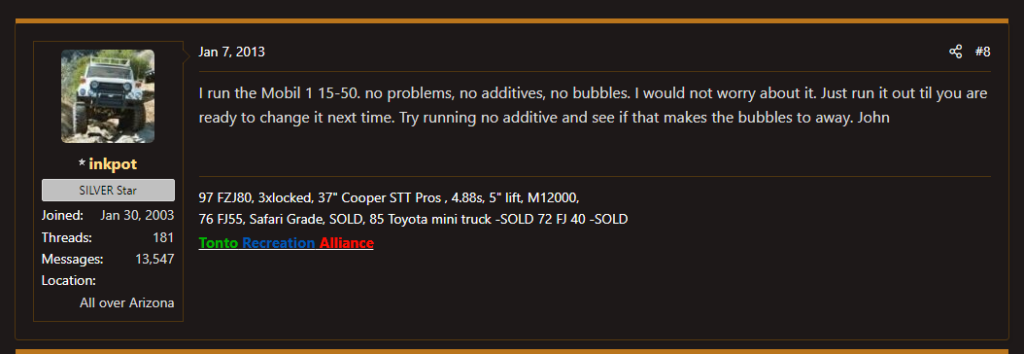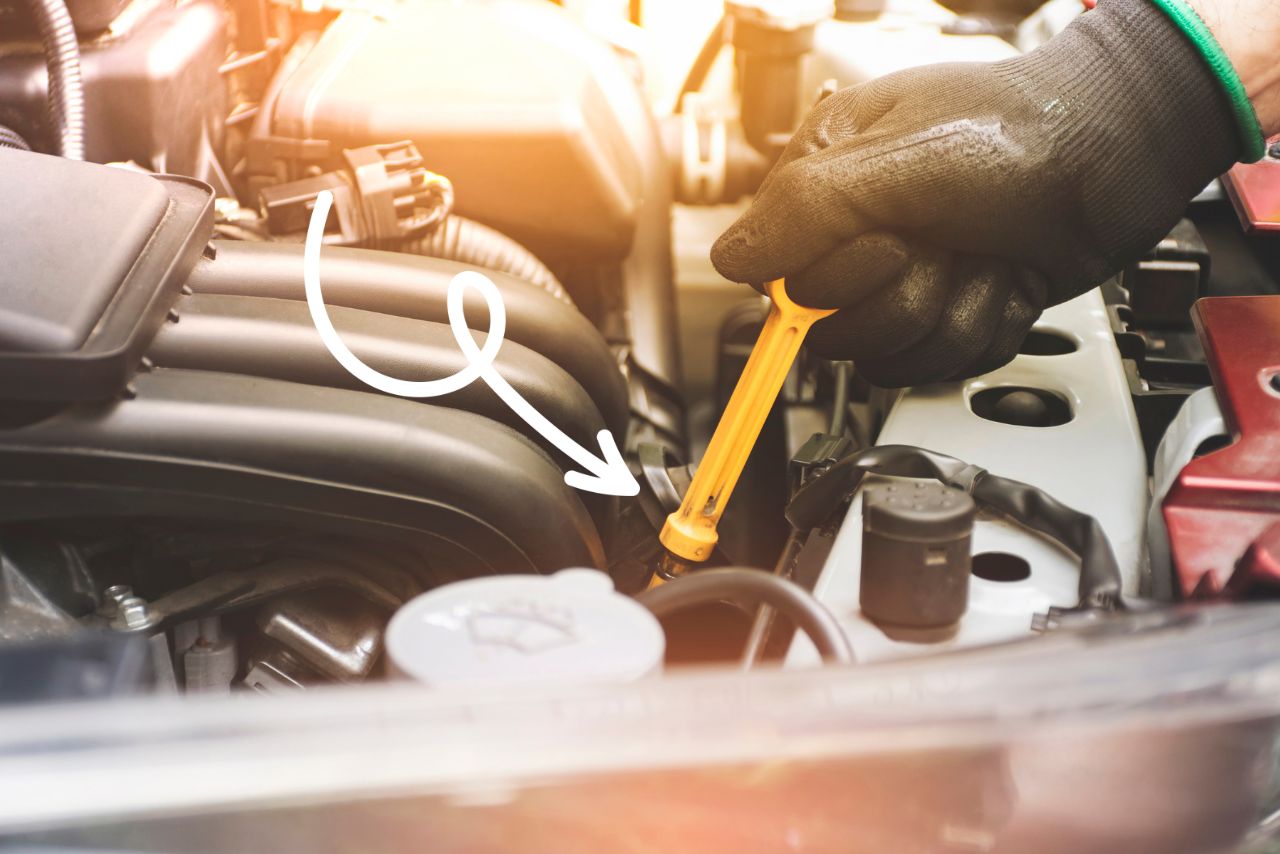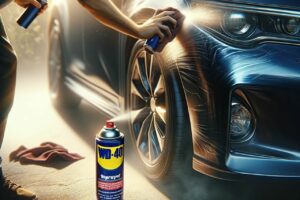Ever spotted air bubbles on your engine oil dipstick and wondered what they signify? This phenomenon could stem from various factors, including insufficient anti-foam additives, oil contamination, or even air infiltrating the system.
In this Bubbles On Oil Dipstick guide, we’ll unravel the mystery behind these bubbles, exploring potential causes and offering insights into when to be concerned.
Understanding what’s happening on your dipstick can provide valuable clues about your engine’s health.
Air bubbles on the dipstick? Possible causes include insufficient anti-foam additives, oil contamination, or air intake. While occasional tiny bubbles are normal, consistent or large bubbles may need attention. Check oil levels and additives, and consult if concerns persist. To avoid this problem use Mobil 1 15-50.
One of our user has fixed this problem using our method you can in the below image:

Table of Contents
What Does Bubbles on The Oil Dipstick Mean?
Air bubbles on the oil dipstick can indicate various factors affecting the engine oil.
While small, occasional bubbles are generally normal and may result from factors like condensation or minor foaming, consistent or large bubbles may signal potential issues.
Possible causes include insufficient anti-foam additives, oil contamination, or air entering the system.
Regular monitoring, checking oil levels, and consulting with automotive experts can help determine if further action or investigation is necessary for optimal engine health.
5 Causes of bubbles on oil dipstick:
| Cause | Description |
|---|---|
| Overheating | When an engine overheats, it can cause the oil to break down and form bubbles. This is because the heat causes the oil to become thinner and less viscous. |
| Low oil level | If the oil level is too low, it can cause air to be drawn into the engine, which can lead to the formation of bubbles. |
| Contamination | If the oil becomes contaminated with water or other foreign substances, it can also cause bubbles to form. |
| Leak | If there is a leak in the engine, it can allow air to enter the system, which can lead to the formation of bubbles. |
| Mechanical problems | In some cases, bubbles on the oil dipstick can be a sign of a more serious mechanical problem, such as a blown head gasket or a cracked engine block. |
1. Overfilling of oil:

Overfilling of oil can be a common cause of bubbles on the oil dipstick. When the oil level exceeds the maximum mark on the dipstick, it can cause an increase in pressure within the engine.
As a result, air bubbles can form in the oil, leading to a foamy consistency. This can be problematic, as the oil may not be able to properly lubricate the engine components, and may lead to engine damage.
It is important to always follow the manufacturer’s recommendations for oil level and type. It is also important to ensure that there are no leaks in the engine that could cause the oil level to rise above the maximum mark.
If you notice bubbles on the oil dipstick, it is recommended to have the oil level checked and adjusted, if necessary, to prevent any potential engine damage.
2. Water or coolant mixing with oil:
If you’ve noticed bubbles on your oil dipstick, it’s crucial to investigate the cause quickly.
One common cause of this issue is water or coolant mixing with your engine oil. This can occur due to a variety of reasons, including a blown head gasket, a cracked engine block, or a damaged cylinder head.
When water or coolant mixes with oil, it creates a frothy consistency that can cause bubbles to appear on your dipstick.
This can be an early warning sign of a much more severe problem that could lead to significant engine damage if left untreated.
To prevent further damage, it’s essential to have your vehicle inspected by a professional mechanic as soon as possible.
They can diagnose the issue and recommend the appropriate repairs to get your vehicle back on the road safely.
More: Can You Change Oil Filter Without Changing Oil? (REVEALED!)
3. Air leaking into the oil system:
Air leaking into the oil system can be a common cause of bubbles on the oil dipstick. This can occur when there is a breach in the engine’s gasket or seal, causing air to enter the oil system.
The presence of air bubbles on the dipstick is an indication that the oil is aerated, which can lead to engine damage if not addressed. It’s important to check for any leaks or damage to the gasket or seal and have it repaired as soon as possible.
In addition, regular maintenance of the engine, such as changing the oil and oil filter, can help prevent issues with air leaking into the oil system.
If you notice bubbles on the dipstick or any other unusual symptoms with your engine, it’s best to have a qualified mechanic inspect and diagnose the problem to avoid further damage.
More: Can Car Air Filters Be Cleaned and Reused? (We Tried it Out!)
4. Engine overheating:
If you find bubbles on the oil dipstick of your engine, it’s a sign that something is wrong.
One possible cause of this is an overheating engine. Overheating can occur due to various reasons such as a malfunctioning radiator, a blocked coolant system, or a damaged water pump.
When the engine overheats, the coolant boils, and the pressure in the system increases. This pressure can cause the coolant to leak into the oil system, which can result in bubbles on the dipstick.
If left unaddressed, an overheating engine can cause severe damage to the engine’s components, leading to costly repairs or even replacement. Therefore, it’s crucial to address the overheating issue as soon as possible.
You can start by checking the coolant level and ensuring that the radiator and coolant system are clean and functioning correctly. If the problem persists, seek the assistance of a professional mechanic to diagnose and repair the issue.
5. Faulty oil pump:
If you notice bubbles forming on your oil dipstick, it could be a sign of a faulty oil pump. The oil pump plays a vital role in ensuring that the engine oil is circulated properly throughout the engine.
When the oil pump is not functioning correctly, it can lead to air getting trapped in the oil, causing bubbles to form on the dipstick. This can be a serious issue as it can lead to engine damage if not addressed promptly.
If you suspect that your oil pump is faulty, it’s essential to have it checked by a professional mechanic. They will be able to diagnose the issue and advise on the necessary repairs.
Regular oil changes and proper maintenance of the oil pump can help prevent this issue from occurring. Don’t ignore bubbles on your oil dipstick; it could be a warning sign of a more significant problem.
Effects of Bubbles On Oil Dipstick:

Reduced lubrication of engine parts:
Reduced lubrication of engine parts can lead to serious damage and costly repairs. One factor that can contribute to this problem is the presence of bubbles on the oil dipstick.
When oil is contaminated with air, it can cause bubbles to form, which can lead to reduced lubrication. This can happen for a number of reasons, such as overfilling the oil or a malfunctioning oil pump.
To avoid this issue, it’s essential to regularly check the oil level and ensure that it’s at the correct level. If you notice bubbles on the dipstick, it’s important to address the issue immediately.
Instruct your mechanic to check for any potential problems such as a leak in the oil system or a faulty oil pump. By taking these precautions, you can help prevent reduced lubrication and keep your engine running smoothly.
Increased engine wear and tear:
If you’ve recently noticed bubbles on your oil dipstick, it’s important to address the issue immediately.
These air bubbles can indicate an increased engine wear and tear. When bubbles mix with oil, it creates a foamy consistency, which can lead to reduced lubrication and increased friction in the engine.
This, in turn, can cause excessive wear and tear on the engine’s components. To remedy the situation, it’s crucial to identify the root cause of the air bubbles.
One common culprit is a faulty PCV valve, which can cause excess pressure buildup in the engine. Another possible cause is a worn out gasket or seal, which can allow air to enter the oil system.
In either case, it’s important to have the issue addressed by a qualified mechanic as soon as possible to prevent further damage to your vehicle’s engine.
Reduced engine performance:
Reduced engine performance can be a result of several factors, one of which is the presence of bubbles on the oil dipstick.
These bubbles can occur due to a variety of reasons, including overfilling the oil, a clogged breather tube, or a malfunctioning oil pump.
It is essential to monitor the oil level and quality regularly to ensure that the engine is functioning correctly. If bubbles are present on the dipstick, it is crucial to check the oil level and make sure it is not overfilled.
If the level is normal, it may be necessary to replace the breather tube or oil pump. Ignoring the presence of bubbles can lead to decreased engine performance and even damage.
Therefore, it is recommended to follow the manufacturer’s instructions for oil changes and maintenance and seek professional assistance if any abnormalities are noticed in the engine’s performance.
Risk of engine failure:
It is crucial to understand the risk of engine failure due to the effect of bubbles on the oil dipstick. When checking the oil level, it is important to ensure that the engine is turned off and the dipstick is wiped clean before reinserting it.
Bubbles on the dipstick can indicate the presence of air in the engine oil, which can lead to engine failure if not addressed.
Air bubbles can cause the oil to become thinner and less effective at lubricating engine parts, leading to increased friction and wear over time. This can eventually result in engine failure and costly repairs.
To prevent this, it is important to address any air leaks in the engine and ensure that the oil is changed regularly. By taking these precautions, you can reduce the risk of engine failure and keep your vehicle running smoothly for years to come.
You can watch this video to fix this problem ASAP:
Solutions to bubbles on oil dipstick:

Drain and replace oil:
If you’re experiencing bubbles on your oil dipstick, it could be a sign of a serious problem in your engine. However, before you panic, there are a few things you can do to address the issue.
Firstly, make sure you’re checking your oil level correctly. Ensure that you’ve allowed the engine to cool down for at least 10 minutes before checking the dipstick and that the vehicle is parked on a level surface.
If you’re still seeing bubbles on the dipstick, it may be time for an oil change. Drain the oil from the engine and replace it with the recommended type and viscosity for your vehicle.
It’s important to note that bubbles on the dipstick could also indicate a blown head gasket or a cracked engine block, so if the issue persists after an oil change, it’s best to take your vehicle to a mechanic for a thorough inspection.
Check coolant system for leaks:
To prevent bubbles on your oil dipstick, it is important to check your vehicle’s coolant system for leaks.
The coolant system is responsible for regulating the engine’s temperature, which helps prevent overheating and damage to the internal components.
If there is a leak in the coolant system, the engine may not be able to properly regulate its temperature, leading to the formation of bubbles on the oil dipstick.
To check for leaks, inspect the hoses, radiator, water pump, and thermostat housing. Look for any signs of cracks, corrosion, or damage.
If you notice any leaks, it is important to address them promptly to prevent further damage to your engine.
Instruct a qualified mechanic to repair or replace any damaged components to ensure the proper functioning of the coolant system and prevent bubbles on your oil dipstick.
Check for air leaks in the oil system:
Checking for air leaks in the oil system is crucial for maintaining the efficiency of your vehicle and preventing damage to the engine.
Air leaks can cause bubbles on the oil dipstick, indicating a problem in the oil system. To check for air leaks, start by inspecting the oil filter and oil pan gaskets for any signs of wear or damage.
Check for loose connections or cracks in the oil lines and hoses. Use a pressure gauge to test the oil pressure and ensure it falls within the manufacturer’s recommended range.
If you still notice bubbles on the dipstick, it’s time to take your vehicle to a professional mechanic to diagnose and fix the issue.
Ignoring air leaks in the oil system can lead to reduced engine performance and potential engine failure. Regularly checking for air leaks and taking preventative measures can save you from costly repairs in the future.
Check engine for overheating:
If you’ve noticed bubbles on your oil dipstick, it could be a sign of an overheating engine. This is a common issue that can cause serious damage if not addressed promptly.
To diagnose the problem, start by checking your engine’s coolant levels and ensuring that your radiator is working properly. If you’re still experiencing overheating, it may be time to replace your thermostat or water pump.
You should also inspect your engine’s oil to see if it’s contaminated with coolant or other fluids. If you’re unsure how to perform these checks, consult your owner’s manual or take your vehicle to a trusted mechanic.
Remember, ignoring an overheating engine can lead to costly repairs and even engine failure. So, don’t hesitate to take action and ensure that your vehicle is running safely and efficiently.
Replace faulty oil pump:
If you’re experiencing bubbles on your oil dipstick, it may be due to a faulty oil pump. It’s crucial to address this issue as soon as possible, as a malfunctioning oil pump can lead to engine failure.
The first step is to purchase a replacement oil pump that is compatible with your vehicle’s make and model.
Then, follow the manufacturer’s instructions to remove the old pump and install the new one.
It’s important to take your time and be precise during this process to ensure that the pump is installed correctly.
Once the new pump is installed, start the engine and check the oil pressure gauge to ensure that it’s reading at the correct level.
If the bubbles on the dipstick persist, it may be indicative of another issue such as a blown head gasket or a cracked engine block, and you should take your vehicle to a professional mechanic for further diagnosis.
Conclusion and final thoughts 💭
Bubbles on oil dipstick can indicate a serious issue with your car’s engine. By understanding the causes and solutions, you can take the necessary steps to ensure the longevity and performance of your vehicle.
Regular maintenance and inspection of your car’s oil and engine system can help avoid potential issues and keep your car running smoothly.
FAQs:
1. What causes bubbles on the oil dipstick?
Bubbles on the oil dipstick can be caused by a variety of issues, including a cracked engine block, a faulty oil pump, air leaks in the oil system, and an overheating engine.
2. How can I prevent bubbles on the oil dipstick?
Regular maintenance and inspection of your vehicle’s oil and engine system can help prevent bubbles on the oil dipstick. Checking for air leaks in the oil system and addressing any leaks promptly can also help prevent this issue.
3. What should I do if I notice bubbles on the oil dipstick?
If you notice bubbles on the oil dipstick, it’s important to take action promptly to prevent potential damage to your engine. Start by checking your vehicle’s oil level and inspecting the coolant system for leaks. If the issue persists, it’s best to take your vehicle to a professional mechanic for further diagnosis.
4. Can bubbles on the oil dipstick lead to engine failure?
Yes, bubbles on the oil dipstick can be indicative of serious issues with your vehicle’s engine. Ignoring this issue can lead to reduced engine performance and potential engine failure, so it’s important to address it promptly.
5. How can I replace a faulty oil pump?
Replacing a faulty oil pump involves purchasing a replacement pump that is compatible with your vehicle’s make and model, removing the old pump, and installing the new one. It’s important to follow the manufacturer’s instructions and take your time to ensure that the new pump is installed correctly.
Latest Posts:
- Can WD-40 Remove Scratches on Cars? (Hint: Yes, but…)
- Can You Use a Drill to Polish Your Car? (We Tried it Out!)
- Should You Cover Car Scratches With Stickers? (REVEALED!)
- Buick Service Stabilitrak: (Causes & 100% Guaranteed Fix!)
- Common Holden Trax Problems (Causes & 100% Proven Fixes!)
- Jeep Commander Transmission Over Temp: (Guaranteed Fix!)











Leave a Reply